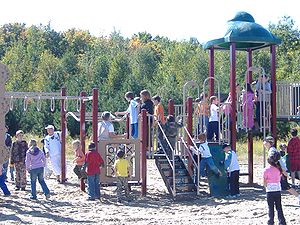From The Peopling of New York City
Contents |
Background
Parks are commonly known as specific places for people to bring their children to play, walk their dogs, and participate in athletic games. But what is less commonly known is the reason for their existence in urban settings and cities. Here we will explore: the purpose of parks in urban settings, how parks have changed over time, parks as a method of social reform, and their relationship with immigrants today.
Purpose
During the nineteenth century, empty spaces were created into parks because there was a demand to balance the stress and vices that came with industrialization, urbanization, and commercialization. Park advocates have linked the accommodations and need for parks with the attempt to solve and/or ameliorate urban problems. These vices/urban problems that were considered to be increasingly problematic in cities at the time include: “alcoholism, prostitution, psychological degeneration due to lack of exercise, disease, delinquency, and the absence of shared civic order”.
How Have Parks Changed?
Pleasure Ground (1850-1900)
Pleasure Ground was described as “an antidote to the ills of rapidly industrialized city, visually and programmatically its antithesis, with a curving, picturesque landscape and emphasis on mental refreshment”. During this time reformers/park advocates wanted a respectable setting where a man could appear in public with his wife and children. This setting would allow the man to recognize his role in the family as the head of the household. According to Charles Eliot, park advocate and president of Harvard University (at the time this article was written in 1980), parks were supposed to promote and encourage “a high standard of family life” because as he reasoned, “the pleasures men share with their wives and children are apt to be safer pleasures than those they take by themselves.” Therefore, men who would frequent parks with their families would be less encouraged and tempted to indulge in the very vices that come from the stress of a nine to five job in the city, especially at a time when industrialization and commercialization were booming. Because urban settings vary in their pace and lifestyle from suburban and rural settings, reformers/park advocates wanted to include a place devoted to nature to offset the unnatural vices of urbanization.
Reform Park (1900-1930)
Reform Park made parks accessible to the working class. In the previous model, the pleasure ground was only made accessible to middle-class families (who at the time attended parks frequently). Working class families wanted a place for their children to enjoy as well, but because parks were located at a costly distance, they were originally excluded from these "wholesome recreational opportunities." Park advocates at this time also promoted playgrounds in parks because physical exercise in a safe setting (rather than the street) was crucial. It may also be noted that in the previous model, parks did not have playgrounds because park advocates at the time assumed that children would be entertained by their mothers.
Recreation Facility (1930-1965)
Recreating Facility was a period when parks were recognized as a functioning part of cities, along with schools, post offices, and hospitals etc…During this time park advocates reverted back to the motivation of promoting family togetherness. The idea was that “Mom, Pop and the kids must do things as a group”. So programs and facilities were created with the family in mind. This was also the time when athletic leagues were being organized in parks, which included sports such as: softball, tennis, table tennis, basketball, and golf. Recreational activities included: folk dancing, field days, picnics, and festivals.
Open-Space System (1965-Present)
The new attitude towards the perception of the usefulness of open space was "valuable wherever found." The central goal during this time was to help revitalize the inner city: visually, economically, and socially. Park planners defied traditional standards of size, shape, topography, and location of parks. The 1960's saw park advocates/reformers lay an increased emphasis on riot control, thereby suggesting that they were targeting their youth population. Therefore parks began to implement cultural programs, which included: concerts, dances, and celebrations etc. Park advocates also wanted to appeal to the middle-class where their design was focused on providing a “safe and attractive” environment for “the businessmen and women on their lunch breaks from downtown offices-and the upper-middle-class suburban shoppers”.
Social Reform
There are four virtues that parks wanted to promote in society: public health and prosperity, and normative concerns for social coherence and democratic equality.
- Health-Providing a safe and respectable place for people to engage in athletics.
- Prosperity-Parks provide a safe environment for children and youth, they indirectly reduce costs for the police and justice systems. Secondly, because they promote the development of “responsible and involved citizen[s],” parks contribute to society by fostering such attitudes.
- Social Coherence-By providing a place for youth to play and grow amongst their peers, parks deter juvenile crime because children are exposed to social experiences at an early age. Since the implementation of playgrounds allow children to play amongst children of all ages and races, they also learn to cooperate with one another at an earlier age.
- Democratic Equality-Parks provide a place for a diverse group of people to cooperate and compete athletically with one another locally.


